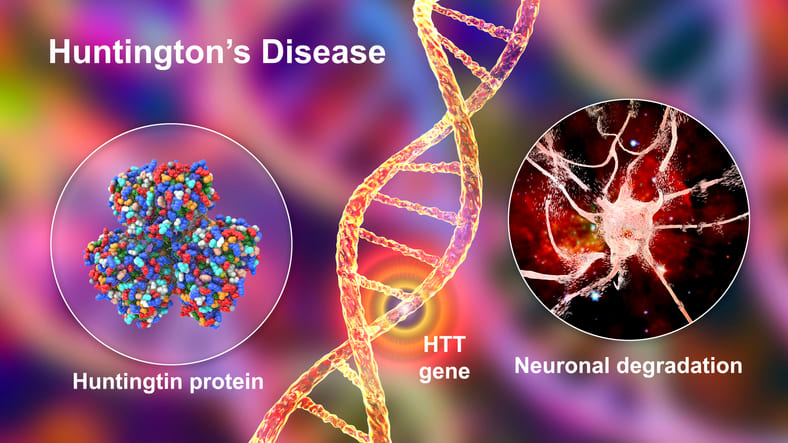
[6 min read]
In this article:
- The Huntington’s Disease Society of America estimates that there are currently 41,000 people in the U.S. with symptomatic Huntington's Disease, and another 200,000 at risk of inheriting the condition.
- Huntington's is always fatal, and until now there have been no successful treatments.
- A new gene therapy has shown surprising success in reducing Huntington's symptoms, giving new hope to patients and their families.
- A Providence Swedish expert explains more about Huntington's and why treating it has been so challenging.
Huntington's Disease is an inhereted, fatal, neurodegenerative disease for with there has been no successful treatment until now. Researchers have successfully treated the conditon with a new gene therapy.
Huntington’s disease (HD) is a progressive, neurodegenerative disorder that has long posed significant challenges to patients, physicians and researchers because of its origins and complex symptomatology. HD, which is also known as Huntington’s chorea, causes degeneration of nerve cells in the brain, affecting movement, cognition and behavior.
Recently, a new treatment has emerged, offering fresh hope for patients with Huntington’s Disease. To learn more about this new treatment and its potential to help patients and their families, we spoke with Pravin Khemani, M.D., the medical director of the Movement Disorders Program at the Swedish Neuroscience Institute.
Understanding Huntington’s Disease
Huntington’s disease is caused by a genetic mutation that leads to the production of the abnormal huntingtin protein, which gradually deteriorates nerve cells in the brain. This progressive degeneration causes symptoms such as involuntary movements (chorea), emotional disturbances and cognitive decline, which often lead to incapacitation, and eventually, death.
Typically, symptoms emerge between the ages of 30 and 50, though they can appear earlier or later, with the average disease progression lasting 10 to 15 years. Huntington’s also has the tragic distinction of an extremely high associated suicide rate, that is five times higher than the general population.
The Huntington’s Disease Society of America estimates that there are currently 41,000 people in the U.S. with symptomatic Huntington's Disease, and another 200,000 at risk of inheriting the disease.
Comparisons to ALS and MS
Huntington’s is classified as a neurodegenerative condition, along with Amyotrophic Lateral Sclerosis (ALS) and Multiple Sclerosis (MS), but there are significant differences. ALS primarily affects motor neurons, leading to muscle weakness and respiratory failure, while MS is an autoimmune disorder targeting the protective covering of nerves, resulting in varied neurological symptoms. It is distinct in its genetic inheritance and symptom progression.
“With some diseases, such as Parkinson’s, there can be some environmental factors. The name of the field [studying this] is epigenetics, which is an interaction of the environment with genes that predispose someone to develop [a disease like] Parkinson’s,” says Dr. Khemani. “It's a perfect storm when those genes interact with toxins in the environment, such as pesticides, other solvents and chemicals.
A breakthrough treatment
Historically, HD has seen limited progress in treatment due to the challenges of targeting the underlying genetic causes and the difficulty of crossing the blood-brain barrier to deliver therapies.
But a recent groundbreaking treatment developed at the University College London Huntington’s Disease Center is offering patients and families new hope. The therapy utilizes genetic technology molecular to target the faulty huntingtin gene. The treatment is administered during brain surgery that can take up to 12 hours.
“It has been a very long and arduous journey with a lot of failures,” Dr. Khemani notes. “There have been several gene treatments tried in animal models and small patient trials, but none have been as successful as this one, which stands head and shoulders above what we have seen in the past.”
Challenges and considerations
Despite the promising results, challenges remain. Notably, individuals with advanced HD may not benefit from the new therapy due to the extent of neural deterioration. Additionally, the treatment is highly invasive and expensive — estimated to be around $250,000 — posing potential accessibility challenges for some patients.
“We need to keep in mind that it’s too early to call this a cure — even with a 70% improvement rate for symptoms,” advises Dr. Khemani. “Will there be even more improvement two or three years down with the disease halted completely or will patients need to be retreated? We don’t know yet.”
Find a physician or advanced practice clinician (APC)
Our experts at the Swedish Neuroscience Institute offer comprehensive, progressive diagnosis and treatment for a wide range of spine, brain and central nervous system conditions. Telehealth options are available. Visit us on the web or call 206-320-3940. You can also use our provider directory to find the doctor that’s right for you.
Swedish Virtual Care connects you face-to-face with a nurse practitioner who can review your symptoms, provide instruction, and follow up as needed. If you need to find a provider, you can use our provider directory.
Additional resources
The Swedish MS Center: New leadership committed to our tradition of visionary care
Research at Swedish is saving lives. Your support will help it continue.
This information is not intended as a substitute for professional medical care. Always follow your health care professional’s instructions.
Providence Swedish experts in the media
Follow us on Facebook, Instagram and X.
About the Author
More Content by Swedish Neuroscience Team





















